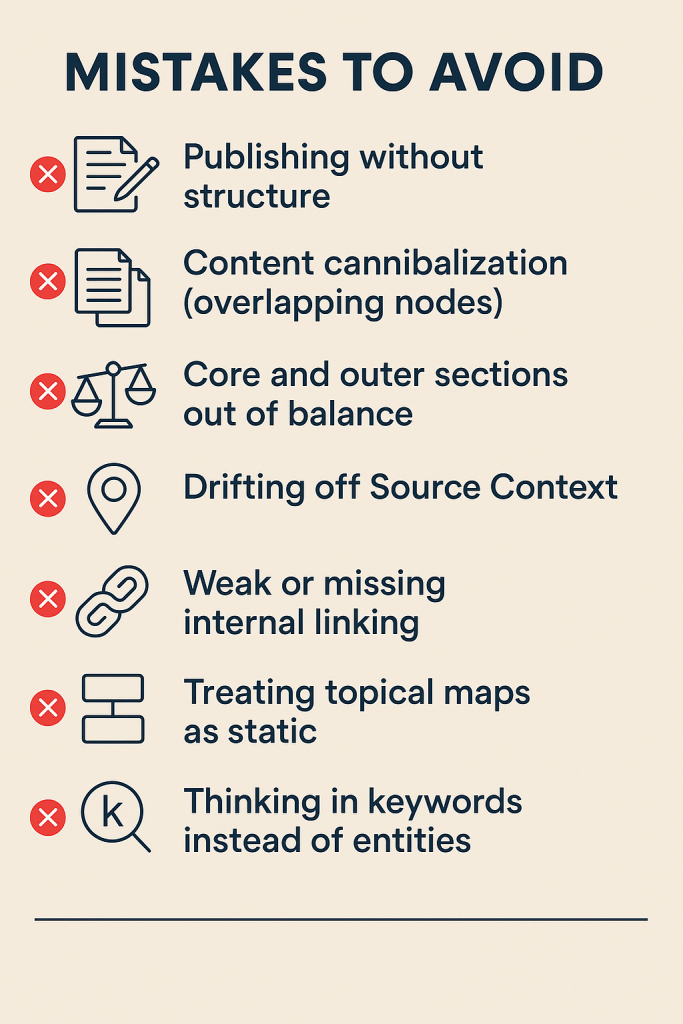Over the past few weeks, we’ve shared notes on three building blocks of semantic SEO: Source Context, Central Entities, and the distinction between Core and Outer Sections in topical maps.
Each of those concepts laid the foundation for understanding how search engines interpret authority and completeness. But knowing the pieces isn’t enough, the real challenge is putting them together.
That’s where this note comes in. Today, we’ll look at how to actually build and scale a topical map. You’ll see how Source Context acts as a compass, how the central entity anchors the structure, and how core and outer sections expand into a complete semantic network. We’ll also walk through two practical examples, one for a Cybersecurity Services company and one for a Project Management SaaS product, to show how this works in action.
Definition
A topical map is a structured framework that organizes your content around a central entity and expands into logically connected topics. It defines relationships between core sections (the pillars of authority) and outer sections (supportive context).
This is not just a planning tool. A topical map reflects how search engines like Google interpret knowledge: as entities connected by relationships. When you build one, you’re aligning your site with the same semantic structure Google uses in its Knowledge Graph.
Why It Matters
Google’s ranking systems rely less on isolated keywords and more on semantic understanding. They want to know:
- What is this site about?
- How completely does it cover the subject?
A topical map answers both:
- The core section tells Google what defines your authority.
- The outer section shows that you’ve covered the breadth of related context.
Sites without a map usually:
- Cannibalize themselves with duplicate or overlapping content.
- Chase tangents that dilute authority.
- Publish ad hoc, creating gaps that competitors exploit.
Sites with a strong topical map, by contrast, build authority signals at scale: every piece reinforces the structure, and the whole becomes greater than the sum of its parts.
Source Context as the Compass
Before you begin, you must define your Source Context, the commercial or informational purpose of your site. This prevents you from building a map that looks complete on paper but drifts from your actual business goals.
- Cybersecurity company: The Source Context is selling managed security services. Your topical map should emphasize service-related entities (audits, compliance, penetration testing) while supporting them with informational content.
- Fitness coaching business: The Source Context is selling programs and coaching packages. The map must highlight training methods, nutrition, recovery, and performance optimization while supporting them with related lifestyle and tools content.
Source Context is the filter. It determines what belongs in the map, how content clusters are prioritized, and how both core and outer sections drive relevance toward business outcomes.
Without it, a topical map is just a content calendar. With it, the map becomes a semantic asset aligned with your goals.
The Building Process
1. Define the Central Entity
Every topical map starts with a central entity, the subject that appears consistently across your site. It’s the anchor that connects every piece of content.
- For a legal site: “Personal Injury Law.”
- For a travel site: “European Travel.”
- For a SaaS company: “Project Management Software.”
This entity should appear not just in one article but across your entire site’s language, metadata, and link structures.
2. Identify the Core Section
The core section is made up of non-negotiable topics directly tied to the central entity. Without these, your site cannot claim authority.
- Legal site: negligence, liability, compensation, statutes of limitation.
- Travel site: visas, itineraries, transportation, accommodations.
- SaaS site: features, integrations, pricing, onboarding.
Core pages should interlink tightly, forming a semantic cluster that reinforces the central entity.
3. Expand Into the Outer Section
The outer section builds depth. These topics aren’t pillars but they provide richness and completeness.
- Legal site: case studies, famous lawsuits, jury selection, expert witnesses.
- Travel site: local cuisines, cultural customs, packing tips, travel insurance.
- SaaS site: productivity hacks, case studies, industry benchmarks, workflow templates.
These topics often capture long-tail queries and informational intent, but their value is only realized if they point back to the core.
4. Structure Relationships
A topical map must be a network, not a flat list. Relationships matter as much as nodes.
- Core to Core: Interlink core pages to reinforce authority.
- Outer to Core: Always point back to the core to avoid isolation.
- Outer to Outer: Create supporting bridges where natural overlaps exist.
This relational structure mirrors how Google’s Knowledge Graph models entities. For instance, “Malware Prevention” connects not only to “Cybersecurity” (core) but also to “Famous Breaches” (outer).
5. Scale With Semantic Depth
Scaling a topical map doesn’t mean pumping out more pages. It means extending coverage without breaking coherence.
- Add new nodes where you identify topical gaps.
- Merge or consolidate where you find overlap.
- Continuously update to reflect changing queries or industry shifts.
Scaling requires balance: too much outer without reinforcing the core weakens authority. Too much core without breadth makes the site feel shallow.
Practical Techniques for Building Topical Maps
- Entity Extraction Use NLP tools (e.g., Google’s Natural Language API, spaCy, or ChatGPT) to pull entities from competitor sites or SERPs. This helps reveal the concepts Google associates with a topic.
- Example (baseline): A cybersecurity site analyzing SERPs for “network security” might extract entities like firewall, intrusion detection, DDoS attack, and VPN. These become candidate nodes for your core or outer section.
- Example (finding gaps): If competitors cover “firewall” and “VPN” but ignore zero trust architecture or endpoint detection and response (EDR), both surfaced in SERP analysis, those become content opportunities.
- Query Clustering Group related keywords by intent to reveal topical opportunities. Tools like Keyword Insights, LowFruits, or even manual clustering in Excel work well.
- Example: For a fitness coaching site, clustering around “strength training” might yield groups like beginner strength workouts, progressive overload, and compound exercises. Each cluster maps to a page or cluster of pages.
- Internal Link Audits Crawl your site (Screaming Frog, Sitebulb) to map internal linking. Identify where clusters exist and where they are missing.
- Example: On a travel site, “visa requirements” may not link to “travel insurance” or “packing guides,” even though they are semantically related outer topics. Adding those links strengthens the network.
- Schema Markup Use structured data to explicitly connect your content to entities in Google’s Knowledge Graph.
- Example: An article on “Encryption” can include schema linking it to the Wikidata/Schema.org entity for Encryption, reinforcing the connection between your page and the recognized entity.
- SERP Feature Analysis Study Google’s People Also Ask, Knowledge Panels, and Related Searches to uncover hidden nodes for your topical map. These features are direct clues about how Google organizes entities.
- Example: For a SaaS project management tool, “project management software” may surface PAAs like “What is agile methodology?”, “What are Kanban boards?”, and “How do project management tools integrate with Slack?” Each becomes an outer topic that supports the core.
Mistakes to Avoid
- Publishing Without Structure
Producing content reactively, without a bigger plan, leads to scattered coverage where important entities are missing and low-value content bloats the site.
Impact: Google struggles to see authority because the semantic signals are fragmented. - Overlapping Nodes (Content Cannibalization)
Multiple pages targeting the same concept (e.g., three blog posts on “how to recover after a workout”) compete against each other. Instead of reinforcing authority, they split signals and dilute rankings.
Impact: Weak performance in SERPs and wasted crawl budget. - Unbalanced Maps
Some sites overproduce outer content while neglecting core content, or vice versa.
Impact: Outer-heavy maps look unfocused; core-heavy maps look shallow. Both miss the balance Google uses to evaluate authority and completeness. - Ignoring Source Context
Without a compass, sites drift into irrelevant or low-value nodes. For example, a cybersecurity company publishing generic “work-from-home productivity” tips.
Impact: Misaligned maps confuse both users and search engines about what your site is really about. - Neglecting Relationships
A topical map without strong internal linking is just a list. Core and outer nodes must be tied together for Google to interpret hierarchy and relationships.
Impact: Isolated content fails to support the central entity and can remain invisible in rankings. - Static Maps (Failure to Evolve)
Treating topical maps as one-time exercises ignores evolving search behavior and entities.
Impact: Content becomes outdated, gaps appear, and topical authority erodes over time. - Overfocusing on Keywords Instead of Entities
Seeing topical maps as keyword dumps rather than entity networks strips them of semantic richness.
Impact: You end up with keyword-stuffed, thin clusters that don’t capture entity-level authority.
Quick Checklist of Mistakes

Worked Example 1: Building a Topical Map for Cybersecurity Services
Note: This is not a complete topical map, only the beginning of one.
Step 1. Define the Source Context
The Source Context is selling managed cybersecurity services to businesses. That means the topical map must prioritize entities like audits, compliance, and managed protection, not drift into general “tech tips” or consumer security content.
Step 2. Identify the Central Entity
The central entity is Cybersecurity. This entity anchors the entire map and ties directly into the company’s business model.
Step 3. Build the Core Section
The core topics are the pillars of authority, essential for any cybersecurity services provider:
- Network security
- Malware prevention and removal
- Encryption and data protection
- Identity and access management
- Compliance frameworks (HIPAA, GDPR, SOC 2)
- Incident response and recovery
These represent the core service areas. Each should be supported with in-depth service pages and explanatory hubs.
Step 4. Add the Outer Section
The outer topics expand coverage, adding depth and context to the map:
- Famous security breaches and case studies
- Emerging threats (zero-day exploits, ransomware)
- Ethical hacking and penetration testing
- Reviews and comparisons of cybersecurity tools
- Employee security training and best practices
- Trends in cloud and IoT security\
These topics don’t define authority on their own, but they enrich the map and build completeness.
Step 5. Structure Relationships
Connections show how the map works as a semantic network:
- The “Malware prevention” core page links to case studies of ransomware attacks (outer).
- The “Encryption and data protection” page connects to “Trends in cloud security” (outer) and to “HIPAA compliance” (core).
- Outer content like “famous breaches” points back to core services like “incident response,” reinforcing the commercial relevance.
Step 6. Scale with Semantic Depth
Scaling involves expanding coverage in ways that align with Source Context:
- Add outer nodes like “Zero Trust Architecture” or “Endpoint Detection and Response (EDR)” if competitors haven’t covered them.
- Consolidate duplicate service pages (e.g., two similar “network security” offerings).
- Update regularly as compliance regulations and security threats evolve.
Worked Example 2: Building a Topical Map for Project Management SaaS
Note: Once again, this is not a complete topical map, only the beginning of one.
To see how this framework comes together, let’s walk through building a topical map for a Project Management SaaS company.
Step 1. Define the Source Context
The Source Context is selling project management software to businesses. This ensures the map emphasizes product features, integrations, and use cases rather than drifting into general productivity content.
Step 2. Identify the Central Entity
The central entity is Project Management Software. This entity must be reflected in the site’s structure, navigation, and n-grams.
Step 3. Build the Core Section
The core topics are non-negotiable. They define authority. For this SaaS:
- Task and project management
- Collaboration features (chat, file sharing, comments)
- Integrations (Slack, Google Workspace, Zapier)
- Pricing and onboarding
- Security and compliance
These form the foundation of the map. Each deserves a dedicated page or hub.
Step 4. Add the Outer Section
The outer topics add depth and context. They answer long-tail queries and provide supporting coverage:
- Agile methodology explained
- Kanban vs. Scrum
- Productivity hacks for remote teams
- Best practices for project reporting
- Case studies by industry (marketing, IT, construction)
Each of these reinforces the core by linking back to feature pages or use cases.
Step 5. Structure Relationships
The power of the map comes from its connections:
- The “Agile methodology” page links to the task management feature page (showing the product supports agile workflows).
- The “Integrations with Slack” page links back to both the integrations hub (core) and case studies of remote teams (outer).
- Case studies link to pricing and onboarding pages, guiding readers from context into conversion paths.
Step 6. Scale with Semantic Depth
Scaling the map might involve:
- Adding outer nodes like “How project management tools improve compliance reporting” or “AI in project management.”
- Consolidating redundant nodes if multiple blog posts cover the same concept (e.g., duplicate Kanban articles).
- Updating regularly as new features or integrations are released.
These examples show how Source Context directs the build, the central entity anchors it, and the core and outer sections expand authority in a way that is both semantically complete and commercially aligned.
Bringing It Together
A topical map is not just a content plan. It is a semantic model of your site.
- Source Context acts as the compass.
- The central entity anchors the map.
- The core section proves authority.
- The outer section shows completeness.
- The relationships create a connected network that mirrors Google’s Knowledge Graph.
When you build and scale topical maps with this framework, every piece of content strengthens both your search visibility and your business relevance. You’re not simply publishing articles. You’re constructing a semantic architecture that search engines reward with durable authority.
Beyond the Basics
The framework we’ve outlined, Source Context, Central Entity, Core & Outer Sections, Relationships, and Scaling, captures the essential building blocks for constructing a topical map. Following these fundamentals puts you well ahead of most competitors.
However, the actual process can go much deeper. As outlined in a thorough topical map-building guide, additional steps include:
- Researching the ontology and taxonomy of your central entity (e.g., breakdown into brands, operating systems, features, accessories, user segments)
- Identifying central search intent defining what your audience is really after (e.g., “Find and compare the best mobile phones”)
- Researching buyer personas or ICPs, such as Tech Enthusiast, Budget-Conscious Shopper, Photographer Phil, Business Professional, to tailor content to real user needs
- Identifying authority sources (e.g., GSMArena, PhoneArena, TechRadar, CNET) and reverse-engineering their content strategy to match or surpass their topical coverage
- Finalizing derived and related entities, for instance, smartphones, feature phones, foldables, OS, accessories, network carriers, to ensure comprehensive topical coverage
These additional layers and others give your map both structural depth and strategic precision.
We may dive into some of these and other topics around topical maps in future notes.



